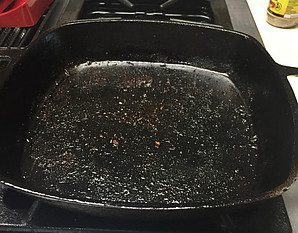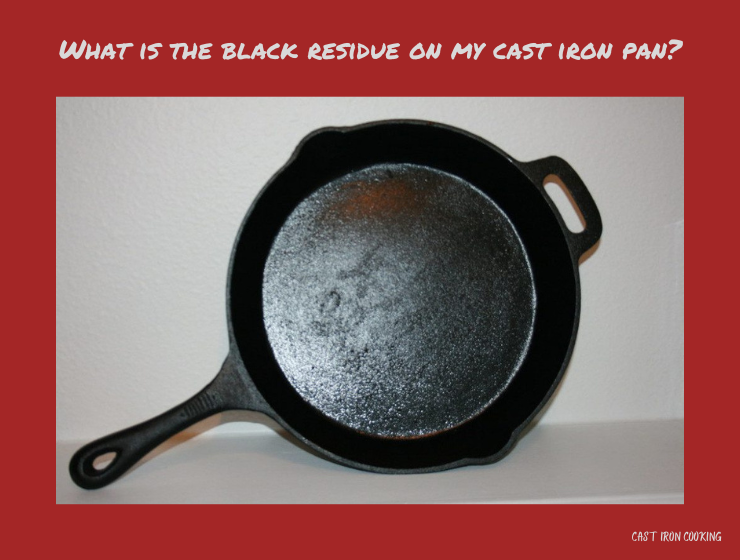Who’s wondering, “What is the black residue on my cast iron pan?”
Either you see black flakes in your food while you’re cooking, or the paper towel or cloth turns dark when you dry your skillet.
It may appear as raised areas on the cooking surface and keep your pan from looking and feeling smooth.
But is it harmful?
Can it be avoided?
And how do you get rid of it?
Or keep it from coming back?
These are all things we will look at.
So let’s get started.
Table of Contents
What is the Black Residue on My Cast Iron Pan?
Black residue, or flakes in your food, are carbon deposits that collect in the pores of the cast iron while cooking. Generally, this happens when you burn the oil or your food, and some of it is still there the next time you use the pan. Over time the carbon residue builds and begins to flake off into your food. The residue is not harmful but also not attractive. Plus, it can leave your food with a charred flavor that some like but many do not. There are at least three ways to remove the black residue and to keep it from coming back.
1. Use an Abrasive to Remove the Black Residue

When oil cooks at a high temperature for a more extended period, we call that seasoning.
And the oil polymerizes and adheres to the pan to form a plastic-like coating that you can’t easily remove.
But when you are cooking and the oil burns, it doesn’t have time to polymerize, so it gets into the pores and stays there.
Unless you wash it all off while you are cleaning, it continues to build and eventually starts flaking off into your food.
Or you might see it turning your cloth dark when washing, drying, or wiping it with oil.
This residue is not a major concern as the black flakes are not harmful.
But when it starts to affect your cooking, you are going to want to deal with it.
Various Abrasives
If that is where you are right now, there are several ways to get rid of the black residue. Here are four of the most common:
- Coarse Salt – add about 1/4 cup salt to the bottom of the pan and begin to rub with a cloth or sponge, mainly where the carbon deposits have built up. Using salt as an abrasive may take a bit of scouring but should not remove any polymerized seasoning. After it’s clean, remove all the salt with a cloth or water. If you use water, dry thoroughly. Finish by adding a thin layer of oil to the surface before storing.
- Stiff Brush – boil an inch or less of water in your pan to loosen the burnt-on oil or food. With your brush and a bit of soap, and while the pan is still hot, scrub until the residue is gone. Dry your pan thoroughly and coat with a thin layer of oil. As with using coarse salt, this method will not affect the polymerized seasoning. A variation of this method would be to add equal parts of vinegar and water and bring them to a boil. Next, remove the pan from the burner, add a tablespoon of baking soda and let it fizz for a bit before washing with the brush. Never let vinegar stay too long in the pan because it will eat away at the seasoning
- Chainmail – in cool cast iron and some warm water, take your chainmail and scrub the entire cooking surface. Rinse and repeat if necessary. As always, dry your pan thoroughly and add a thin layer of oil for protection in between uses. Chainmail should not harm your polymerized seasoning. For a slight variation, see the video below. Or, to learn more about it, read my review on the chainmail I use.
Another Common Method
Self-Clean Oven Cycle – This is a common method for taking off the seasoning so you can start over. Move all racks to the bottom and place your cast iron pan upside down on the top rack. Next, run the self-cleaning cycle. Generally, the oven door won’t unlock until the oven has cooled. So, once it opens and your pan is cool, take it out, wash and dry it. And now begin the seasoning process.
I was hesitant to add the self-cleaning oven method because the instructions for my oven tell me to remove all the racks. It says the oven racks will discolor and may not slide easily after a self-clean cycle.
In addition, the oven gets extremely hot, and I’ve read this might cause some cast iron pans to crack.
It also might be worth it to read my article, Why Strip the Seasoning From My Cast Iron Skillet?
How to Clean a Cast Iron Skillet With Burnt On
2. Pick the Right Oil and Cooking Methods
| Type of Oil | Smoke Point | Flavor Neutral |
| Avacado (Virgin) | 520°F/271°C | NO |
| Safflower | 500°F/260°C | YES |
| Light/Refined Olive | 465°F/240°C | YES |
| Rice Bran | 450°F/232°C | YES |
| Soy Bean | 450°F/232°C | YES |
| Peanut | 450°F/232°C | YES |
| Corn | 450F/232°C° | YES |
| Sesame | 450°F/232°C | NO |
| Sunflower | 440°F/226°C | YES |
| Canola | 425°F/218°C | YES |
| Grapeseed | 420°F/215°C | YES |
| Vegetable | 400°F/204°C | YES |
| Extra-Virgin Olive | 375°F/190°C | NO |
| Vegetable Shortening | 360°F/182°C | YES |
| Coconut | 350°F/176°C | NO |
| Flaxseed | 225°F/107°C | NO |
When you cook with a low smoke point oil on high heat, you will probably burn your oil.
For example, when you sear a steak, you need your pan to get really hot. So you also need to pick a high smoke point oil. I generally use avocado oil for searing and other high-temperature cooking, but many other oils work just as well.
But if you pick an oil with the right smoke point for the temperature you plan on cooking at, you can avoid this.
If you want to avoid your food getting stuck, such as cornbread, use the right amount of oil and follow other instructions and tips to keep cornbread from sticking.
If your eggs are sticking, as mine sometimes do, it may be your seasoning isn’t built up enough, you don’t have enough oil or fat, or from carbon deposits.
When it comes to meat, don’t move or turn it until the bottom naturally releases on its own. But also know that you might have some stuck-on bits of food and residue when you are finished.
And that’s when knowing how to clean the pan properly comes in handy.
3. Learn how to Clean Your Pan Properly
There are many ways to clean your pan, but some methods work better depending on what you cooked and need to clean.
If your pan already has black residue and flakes are getting in your food, I recommend one of the cleaning methods above.
But for avoiding carbon deposits from building in the first place, knowing how to clean your pan after each time you cook is useful.
Most mornings, I clean my skillet the same way: I start with a scraper to get off any bits of food left in the pan, then, with a brush and a bit of soap and water, I clean it. Finally, I dry it and add a thin layer of oil.

That’s all I need for cleaning up after breakfast.
But the rest of the day, it might not be the same.
For example, I made sausage patties for lunch to go with leftover pancakes. After I finished cooking the sausage, my pan looked like the first picture.
So, while my pan was still hot, I ran it under hot water a few times to loosen and remove most of the gunk, then used the scraper and washed it the way I did at breakfast.
I got this idea from the video below,
It was easy, and my pan looked great.
Other Reasons You Might Have Black Residue
I have mainly talked about black residue in general, but not about whether your pan is new or old.
So, I’ll take just a minute to include these thoughts.
You may find that a new pan that has come preseasoned may turn your cloth or paper towel dark when cleaning, drying, or wiping on oil.
This darkness may be due to the factory seasoning and isn’t a problem.
But if you don’t like it, you can put another layer of seasoning or two on top. And the problem should be solved.
Contrast that with an older pan that you might have inherited or picked up a yard sale.
For this type of pan, you can try any of the methods above, but if it’s stubborn, you may want to use the self-clean oven cycle if that’s an option for you. And you’re willing to risk your pan cracking or your oven racks discoloring and not sliding easily.
There are other ways to remove seasoning as well. See my article, Why Strip the Seasoning Off My Cast Iron Skillet.
Otherwise, there are ways to get rid of stubborn black residue, such as stripping your cast iron of its seasoning and starting over.
Always keep in mind: Black residue does not ruin a cast iron pan ever!
There is always a way to get it clean.
Easy Trick to Clean Cast Iron
Final Thoughts
So now, hopefully, you have a much better idea of what the black residue is on your cast iron pan.
It’s most likely carbon deposits that are not harmful and generally not a problem unless you don’t like getting black flakes in your food. Or you are having issues with sticking.
There are multiple ways to clean the carbon residue off your pan, including coarse salt, a stiff brush, chainmail, or a self-cleaning oven cycle.
In addition, using the right oil and cooking temperatures, as well as learning the best way to clean your pan, will keep black residue from coming back.
Have you ever had to deal with black residue in your pan?
If so, how did you clean it, and what measures do you take to keep it from coming back?
Let me know in the comments below.

